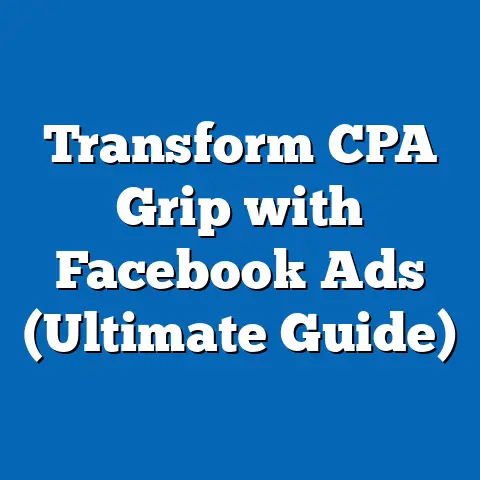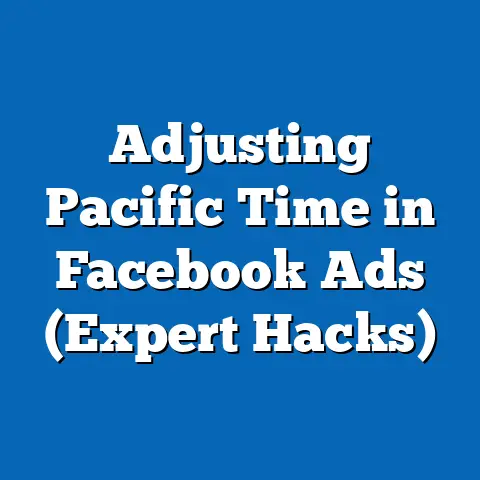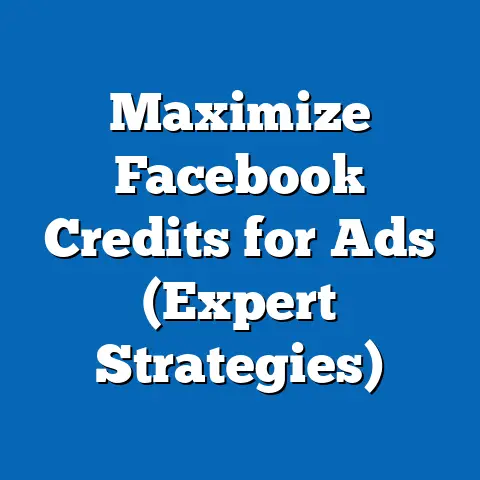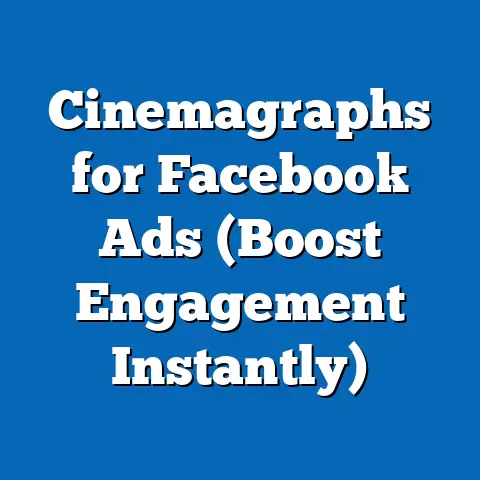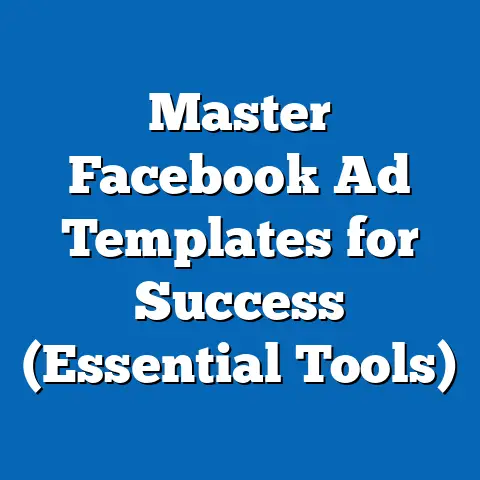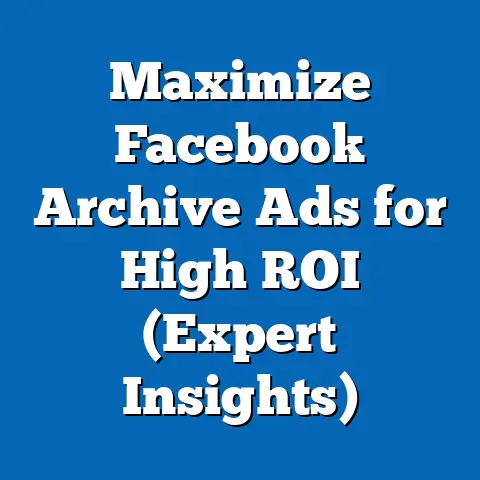Boost CPV Facebook Ads for Maximum Returns (Expert Strategies)
Boost CPV Facebook Ads for Maximum Returns: Expert Strategies
I remember vividly working with a local bakery, “Sweet Surrender,” a few years back. They were struggling to get their name out. They’d tried newspaper ads, flyers – the works. Nothing seemed to stick. Their owner, Sarah, was about ready to throw in the towel, convinced that only big chains could survive. Then, we decided to try Facebook Ads, specifically focusing on a cost-per-view (CPV) strategy. At first, Sarah was hesitant. Another marketing expense? But we started small, creating short, mouth-watering video ads showcasing their signature cupcakes. We targeted local foodies and people interested in baking. The results were astounding. Within weeks, Sweet Surrender saw a significant increase in foot traffic. People were coming in saying, “I saw your cupcake ad on Facebook!” Sarah’s business didn’t just survive; it thrived. This experience solidified my belief in the power of CPV advertising on Facebook, and I’m excited to share my expert strategies with you.
Section 1: Understanding CPV Advertising
Before diving into the strategies, let’s establish a solid foundation. Understanding what CPV advertising is and how it works is crucial for effective implementation.
What is Cost-Per-View (CPV) Advertising?
Cost-Per-View (CPV) advertising is a pricing model where you, as the advertiser, pay each time your video ad is viewed for a certain duration. On Facebook, a “view” typically counts when someone watches at least 3 seconds of your video.
Why is this important? Unlike Cost-Per-Click (CPC) where you pay only when someone clicks on your ad, or Cost-Per-Thousand Impressions (CPM) where you pay for every 1,000 times your ad is shown (regardless of whether it’s viewed), CPV focuses on attention. You’re paying for engaged eyeballs, not just potential exposure.
My Experience: I’ve found CPV particularly effective for brand awareness campaigns. While a click is great, a captivating video viewed for several seconds can leave a much more lasting impression. I once ran a CPV campaign for a new line of eco-friendly cleaning products. The goal wasn’t immediate sales, but to introduce the brand and its mission. We created a short, visually appealing video showcasing the product’s benefits and the company’s commitment to sustainability. The CPV model allowed us to reach a wide audience of environmentally conscious consumers and build brand recognition effectively.
Key Takeaway: CPV is about paying for attention. If you want to get your message across and build brand awareness, it can be a very effective model.
CPV vs. CPC vs. CPM: A Comparison
It’s essential to understand the differences between CPV, CPC, and CPM to choose the right model for your specific goals.
- Cost-Per-View (CPV): You pay when someone watches a certain duration of your video (typically 3 seconds on Facebook). Best for brand awareness, video views, and engagement.
- Cost-Per-Click (CPC): You pay when someone clicks on your ad, regardless of whether they view the content fully. Best for driving traffic to your website, lead generation, and direct response campaigns.
- Cost-Per-Thousand Impressions (CPM): You pay for every 1,000 times your ad is shown, regardless of whether it’s viewed or clicked. Best for broad reach and general brand awareness when targeting a large audience.
Here’s a table to illustrate the differences:
| Feature | CPV | CPC | CPM |
|---|---|---|---|
| Payment Trigger | Video view (3+ seconds) | Click on the ad | 1,000 impressions |
| Best For | Brand awareness, video engagement | Traffic, lead generation, conversions | Broad reach, general brand awareness |
| Pros | Pays for attention, high engagement | Direct response, measurable results | Wide reach, cost-effective for scale |
| Cons | Requires engaging video content | Can attract unqualified clicks | Low engagement, potential for waste |
| Feature | CPV | CPC | CPM |
|---|---|---|---|
| Payment Trigger | Video view (3+ seconds) | Click on the ad | 1,000 impressions |
| Best For | Brand awareness, video engagement | Traffic, lead generation, conversions | Broad reach, general brand awareness |
| Pros | Pays for attention, high engagement | Direct response, measurable results | Wide reach, cost-effective for scale |
| Cons | Requires engaging video content | Can attract unqualified clicks | Low engagement, potential for waste |
My Insight: I often use CPV for initial brand introductions, then retarget those viewers with CPC ads to drive conversions. It’s a powerful combination. Think of it as warming up the audience before asking for the sale.
Actionable Tip: Consider your campaign goals. If you want eyeballs on your brand story, CPV is your friend. If you want immediate action, CPC might be a better fit.
Key Metrics in CPV Advertising
Understanding the metrics that matter in CPV advertising is crucial for campaign optimization. Here are some of the most important:
- View Rate: The percentage of people who saw your ad and watched at least 3 seconds of it. A high view rate indicates that your ad is engaging and relevant to your target audience.
- Cost Per View (CPV): The average cost you pay for each view. This is your core metric for cost-effectiveness.
- Engagement Rate: The percentage of people who interacted with your ad after viewing it (e.g., likes, comments, shares). High engagement suggests that your ad resonated with the audience.
- Click-Through Rate (CTR): The percentage of people who clicked on your ad after viewing it. While CPV focuses on views, a good CTR indicates that your ad is driving action.
- Conversion Rate: The percentage of people who completed a desired action (e.g., purchase, sign-up) after viewing your ad and clicking through to your landing page. This is the ultimate measure of success.
- Return on Ad Spend (ROAS): The amount of revenue generated for every dollar spent on advertising. This metric helps you understand the overall profitability of your CPV campaigns.
Example: Let’s say you spend $100 on a CPV campaign and get 1,000 views. Your CPV is $0.10. If 50 of those viewers click through to your website and 5 make a purchase with an average order value of $50, your ROAS is 1.25 ( (5 * $50) / $100).
My Learning: Don’t just focus on the CPV itself. Look at the entire funnel. A low CPV with a terrible conversion rate is still a losing proposition.
Next Steps: Familiarize yourself with these metrics in the Facebook Ads Manager. You’ll be spending a lot of time analyzing them!
Section 2: Setting Clear Objectives for Your CPV Campaigns
Without clear objectives, you’re essentially throwing money at the wall and hoping something sticks. Defining your goals upfront is paramount.
The Importance of Clear, Measurable Goals
Before you even think about creating an ad, ask yourself: What do I want to achieve with this campaign? Is it brand awareness? Lead generation? Direct sales? The answer will dictate your entire strategy.
Why is this important? Clear goals provide a roadmap for your campaign. They help you:
- Define your target audience: Who are you trying to reach?
- Craft compelling ad creatives: What message will resonate with them?
- Choose the right bidding strategy: How much are you willing to pay for a view?
- Measure your success: How will you know if you’ve achieved your goals?
My Experience: I once launched a CPV campaign for a new mobile app without clearly defining the objectives. We got a lot of views, but very few downloads. We realized we hadn’t properly targeted our audience or crafted a compelling call to action. It was a costly lesson in the importance of goal setting.
Actionable Tip: Write down your goals before you start anything else. Be specific!
Aligning CPV Objectives with Overall Marketing Goals
Your CPV campaigns should never exist in isolation. They need to align with your overall marketing strategy.
How to do it:
- Review your marketing plan: What are your overarching goals for the quarter, year, or even five years?
- Identify supporting roles for CPV: How can CPV help you achieve those goals? For example, if your goal is to increase sales by 20%, CPV can help you build brand awareness and drive traffic to your product pages.
- Set specific, measurable objectives: Translate your overarching goals into specific, measurable objectives for your CPV campaigns.
Example:
- Marketing Goal: Increase sales by 20% in Q4.
- CPV Objective: Increase brand awareness among the target audience by 15% by the end of October, measured by a 15% increase in website traffic from Facebook.
Key Takeaway: Your CPV campaigns should be a strategic component of your broader marketing efforts, not a standalone experiment.
SMART Goals for CPV Advertising
SMART goals provide a framework for setting effective and achievable objectives.
- Specific: Clearly define what you want to achieve. Avoid vague statements like “increase brand awareness.” Instead, say “increase brand awareness among millennials in the US by 20%.”
- Measurable: Quantify your goals so you can track your progress. How will you measure success? (e.g., website traffic, brand mentions, survey results)
- Achievable: Set realistic goals that are within your reach. Don’t aim for the moon if you’re just starting out.
- Relevant: Ensure your goals align with your overall marketing objectives. Is increasing brand awareness among millennials actually relevant to your sales goals?
- Time-bound: Set a deadline for achieving your goals. When do you want to achieve this increase in brand awareness? By the end of the quarter? By the end of the year?
Examples of SMART CPV Goals:
- “Increase video views on our new product demo video by 50% within the first month of launch.”
- “Generate 100 qualified leads from our CPV campaign by the end of Q3.”
- “Improve brand recall among our target audience by 10% within the next two months, as measured by a brand lift study.”
My Pro-Tip: Don’t be afraid to adjust your goals as you go. The market is dynamic, and your initial assumptions might be wrong.
Next Steps: Take some time to define your SMART goals for your next CPV campaign. This is an investment that will pay off in the long run.
Section 3: Targeting the Right Audience
You could have the most captivating video in the world, but if you’re showing it to the wrong people, it’s a waste of money. Effective audience targeting is critical for CPV success.
Advanced Targeting Options on Facebook
Facebook’s targeting capabilities are incredibly powerful. You can reach a highly specific audience based on a wide range of factors.
- Demographics: Age, gender, location, education, job title, relationship status, etc.
- Interests: Hobbies, passions, and topics they engage with on Facebook.
- Behaviors: Purchase history, online activity, device usage, travel habits, etc.
- Custom Audiences: Upload your own customer data (e.g., email lists, phone numbers) to target existing customers or create lookalike audiences.
- Lookalike Audiences: Find new people who are similar to your existing customers.
- Saved Audiences: Combine demographics, interests, and behaviors to create custom audience segments.
My Story: I was working with a small online bookstore that specialized in rare and antique books. We used Facebook’s interest targeting to reach people interested in “rare books,” “antique books,” “collecting,” and “history.” But we also used behavioral targeting to reach people who had recently purchased books online. This combination of interest and behavioral targeting resulted in a highly engaged audience and a significant increase in sales.
Actionable Tip: Don’t rely on broad targeting. Get specific! The more precisely you define your audience, the more effective your campaigns will be.
Audience Segmentation: Tailoring Content for Different Segments
Not all viewers are created equal. Different segments of your audience will respond to different messages.
Why is segmentation important?
- Increased relevance: Tailored content is more relevant to individual viewers, leading to higher engagement rates.
- Improved conversion rates: By addressing the specific needs and interests of different segments, you can improve your conversion rates.
- Reduced ad fatigue: Showing the same ad to everyone can lead to ad fatigue. Segmentation allows you to rotate different ads to different segments, keeping your content fresh and engaging.
How to segment your audience:
- Identify key segments: Based on your target audience, identify the key segments that are most likely to be interested in your product or service.
- Create tailored content: Develop ad creatives that are specifically designed to appeal to each segment.
- Target each segment separately: Use Facebook’s targeting options to ensure that each segment sees the content that is most relevant to them.
Example:
- Segment 1: Millennials interested in sustainable living.
- Content: Video ad showcasing the eco-friendly benefits of your product.
- Segment 2: Baby boomers interested in health and wellness.
- Content: Video ad highlighting the health benefits of your product.
Key Takeaway: One size does not fit all. Tailor your content to resonate with specific audience segments.
Utilizing Facebook’s Audience Insights Tool
Facebook’s Audience Insights tool is a goldmine of information about your target audience. It provides valuable data on their demographics, interests, behaviors, and more.
How to use Audience Insights:
- Access Audience Insights: Go to Facebook Ads Manager and click on “Audience Insights” in the “Tools” menu.
- Choose your audience: Select either “Everyone on Facebook” or “People connected to your Page.”
- Explore the data: Use the filters on the left-hand side to narrow down your audience based on demographics, interests, and behaviors.
- Analyze the results: Review the data on the right-hand side to gain insights into your audience’s interests, behaviors, and demographics.
What can you learn?
- Top Pages: What Pages do they like?
- Location: Where do they live?
- Demographics: What is their age, gender, education level, and relationship status?
- Purchase Behavior: What are they likely to buy?
My Recommendation: Use Audience Insights to validate your assumptions about your target audience. You might be surprised by what you discover.
Next Steps: Spend some time exploring Facebook’s Audience Insights tool. You’ll gain valuable insights that will help you refine your targeting strategies.
Section 4: Crafting Compelling Ad Creatives
Now that you know who you’re targeting, it’s time to create ads that grab their attention and keep them watching. This is where creativity comes into play.
Elements of Effective Ad Creatives for CPV Campaigns
Your ad creative is the first thing viewers will see, so it needs to be compelling and engaging.
- Visuals: Use high-quality images or videos that are visually appealing and relevant to your target audience.
- Copy: Write clear, concise, and persuasive copy that highlights the benefits of your product or service.
- Call to Action (CTA): Tell viewers what you want them to do next. Use strong action verbs like “Learn More,” “Shop Now,” or “Sign Up.”
- Relevance: Make sure your ad is relevant to your target audience and their interests.
- Value: Communicate the value of your product or service. Why should viewers care?
My Experience: I’ve found that short, attention-grabbing videos tend to perform best for CPV campaigns. Aim for videos that are 15-30 seconds long and get straight to the point.
Actionable Tip: Put yourself in your target audience’s shoes. What would grab your attention?
Psychological Triggers that Encourage Engagement
Understanding the psychology behind engagement can help you create more effective ad creatives.
- Curiosity: Create ads that pique viewers’ curiosity and make them want to learn more.
- Urgency: Use language that creates a sense of urgency and encourages viewers to act now.
- Social Proof: Highlight positive reviews, testimonials, or social media mentions to build trust and credibility.
- Emotion: Tap into viewers’ emotions by telling stories that resonate with them.
- Scarcity: Create a sense of scarcity by highlighting limited-time offers or limited quantities.
Example:
- Curiosity: “Discover the secret to a perfect lawn!”
- Urgency: “Limited-time offer: Get 50% off your first order!”
- Social Proof: “Join thousands of satisfied customers!”
- Emotion: “Share your love of reading with a gift subscription!”
- Scarcity: “Only 10 spots left in our upcoming workshop!”
Key Takeaway: Use psychological triggers to make your ads more compelling and engaging.
Case Studies of Successful Ad Creatives
Let’s look at some real-world examples of ad creatives that have led to increased view rates and conversions.
- Dollar Shave Club: Their viral video ad was hilarious, memorable, and clearly communicated the value proposition.
- Old Spice: Their “The Man Your Man Could Smell Like” campaign was witty, engaging, and generated massive buzz.
- Blendtec: Their “Will It Blend?” series was entertaining, informative, and demonstrated the power of their blenders.
What can we learn from these examples?
- Be authentic: Don’t try to be someone you’re not. Be true to your brand’s voice and personality.
- Be entertaining: People are more likely to engage with ads that are funny, interesting, or thought-provoking.
- Focus on the benefits: Highlight the benefits of your product or service, not just the features.
- Keep it short and sweet: Get straight to the point and don’t waste viewers’ time.
My Insight: I’ve noticed that user-generated content (UGC) often performs well in CPV campaigns. People trust the opinions of other consumers more than they trust traditional advertising.
Next Steps: Brainstorm some creative ideas for your ad creatives. Think about how you can use visuals, copy, and calls to action to capture viewers’ attention and encourage them to engage with your brand.
Section 5: Optimizing Landing Pages for Conversions
You’ve got the views, now what? A well-optimized landing page is essential for turning those views into conversions.
The Critical Role of Landing Pages
Your landing page is where viewers will go after clicking on your ad, so it needs to be designed to convert them into customers.
Why is this important?
- First impressions matter: Your landing page is the first impression you’ll make on potential customers.
- Reduce bounce rate: A well-designed landing page will keep viewers engaged and reduce the likelihood that they’ll bounce back to Facebook.
- Increase conversion rates: A clear and persuasive landing page will encourage viewers to take the desired action, whether it’s making a purchase, signing up for a newsletter, or downloading a free e-book.
My Experience: I once worked with a client who was running a successful CPV campaign, but their landing page was terrible. It was slow, cluttered, and confusing. As a result, their conversion rates were abysmal. We redesigned their landing page to be faster, cleaner, and more user-friendly. Conversion rates skyrocketed.
Actionable Tip: Treat your landing page as an extension of your ad. The messaging and visuals should be consistent.
Best Practices for High-Converting Landing Pages
Here are some best practices for designing landing pages that convert:
- Fast Load Times: Optimize your landing page for speed. Use a fast hosting provider, compress images, and minimize code.
- Mobile Responsiveness: Ensure your landing page is mobile-friendly. More and more people are accessing the internet on their smartphones, so your landing page needs to look and function great on all devices.
- Clear Headline and Subheadline: Use a clear and concise headline that grabs viewers’ attention and tells them what your landing page is about. Use a subheadline to provide more detail.
- Compelling Copy: Write persuasive copy that highlights the benefits of your product or service and addresses viewers’ pain points.
- Strong Call to Action (CTA): Use a clear and prominent CTA that tells viewers what you want them to do next.
- High-Quality Images and Videos: Use high-quality images and videos that are relevant to your product or service.
- Social Proof: Include testimonials, reviews, or social media mentions to build trust and credibility.
- Minimal Distractions: Remove any unnecessary elements that could distract viewers from taking the desired action.
Key Takeaway: A fast, clear, and persuasive landing page is essential for turning viewers into customers.
A/B Testing Techniques for Landing Pages
A/B testing, also known as split testing, is a powerful technique for optimizing your landing pages. It involves creating two or more versions of your landing page and testing them against each other to see which one performs best.
How to A/B test your landing pages:
- Identify what to test: Choose a specific element of your landing page to test, such as the headline, CTA, or images.
- Create variations: Create two or more variations of your landing page with different versions of the element you’re testing.
- Split traffic: Split your traffic evenly between the variations.
- Track results: Track the performance of each variation and identify the winner.
- Implement the winning variation: Implement the winning variation on your landing page.
- Repeat the process: Continue testing different elements of your landing page to continuously improve its performance.
What should you test?
- Headlines: Test different headlines to see which one grabs viewers’ attention and encourages them to stay on your page.
- CTAs: Test different CTAs to see which one generates the most clicks.
- Images: Test different images to see which one resonates best with your target audience.
- Copy: Test different versions of your copy to see which one is most persuasive.
- Layout: Test different layouts to see which one is most user-friendly and encourages conversions.
My Recommendation: Start with small changes and test one element at a time. This will help you isolate the impact of each change and identify what’s working and what’s not.
Next Steps: Start A/B testing your landing pages today. Even small improvements can have a big impact on your conversion rates.
Section 6: Budgeting and Bidding Strategies
Knowing how to spend your money is just as important as knowing where to spend it. Effective budgeting and bidding strategies are crucial for maximizing your ROI.
Budgeting Methods for CPV Campaigns
There are two main budgeting methods for CPV campaigns on Facebook:
- Daily Budget: Set a fixed amount you’re willing to spend each day. This is a good option if you want to control your spending and avoid overspending.
- Lifetime Budget: Set a fixed amount you’re willing to spend over the entire duration of your campaign. This is a good option if you have a specific budget in mind and want to ensure that you don’t exceed it.
Which one should you choose?
- Daily Budget: Ideal for ongoing campaigns where you want to maintain a consistent level of spending.
- Lifetime Budget: Ideal for campaigns with a specific start and end date, such as a product launch or a seasonal promotion.
My Experience: I often use a daily budget for initial testing and optimization, then switch to a lifetime budget once I’ve identified a winning strategy.
Actionable Tip: Start with a smaller budget and gradually increase it as you optimize your campaigns.
Bidding Strategies: Manual vs. Automatic
Facebook offers two main bidding strategies for CPV campaigns:
- Manual Bidding: You set the maximum amount you’re willing to pay for each view. This gives you more control over your spending, but it also requires more monitoring and optimization.
- Automatic Bidding: Facebook automatically sets your bids based on your budget and target audience. This is a good option if you’re new to Facebook advertising or don’t have the time to manually manage your bids.
Which one should you choose?
- Manual Bidding: Ideal for experienced advertisers who want to have more control over their spending and are willing to invest the time in monitoring and optimization.
- Automatic Bidding: Ideal for beginners or advertisers who want a more hands-off approach.
My Pro-Tip: Start with automatic bidding to get a feel for the market, then switch to manual bidding once you have enough data to make informed decisions.
Adjusting Bids Based on Performance Metrics
Regardless of whether you’re using manual or automatic bidding, it’s important to monitor your performance metrics and adjust your bids accordingly.
- If your CPV is too high: Lower your bids.
- If your view rate is low: Improve your ad creatives or refine your targeting.
- If your conversion rate is low: Optimize your landing page or adjust your offers.
Key Takeaway: Continuous monitoring and optimization are essential for maximizing your ROI.
Next Steps: Experiment with different budgeting and bidding strategies to find what works best for your campaigns.
Section 7: Measuring Success and Analyzing Data
You’ve launched your campaign, but the work isn’t over. Measuring your success and analyzing your data is crucial for understanding what’s working and what’s not.
Key Performance Indicators (KPIs) to Track
We touched on this earlier, but let’s reiterate the critical KPIs for CPV campaigns:
- View Rate: The percentage of people who saw your ad and watched at least 3 seconds of it.
- Cost Per View (CPV): The average cost you pay for each view.
- Engagement Rate: The percentage of people who interacted with your ad after viewing it (e.g., likes, comments, shares).
- Click-Through Rate (CTR): The percentage of people who clicked on your ad after viewing it.
- Conversion Rate: The percentage of people who completed a desired action (e.g., purchase, sign-up) after viewing your ad and clicking through to your landing page.
- Return on Ad Spend (ROAS): The amount of revenue generated for every dollar spent on advertising.
How to track these KPIs:
- Facebook Ads Manager: This is your primary tool for tracking your ad performance.
- Google Analytics: Use Google Analytics to track website traffic, bounce rates, and conversion rates.
- CRM: If you’re using a CRM, you can track leads and sales generated from your CPV campaigns.
My Insight: Don’t just look at the overall numbers. Segment your data by audience, ad creative, and landing page to identify what’s working best.
Tools for Tracking and Analyzing Ad Performance
In addition to Facebook Ads Manager, Google Analytics, and your CRM, there are a number of other tools you can use to track and analyze your ad performance:
- Tableau: A powerful data visualization tool that can help you make sense of your data.
- Supermetrics: A data integration tool that allows you to connect your Facebook Ads data to Google Sheets or other reporting platforms.
- Hootsuite Analytics: A social media analytics tool that provides insights into your social media performance.
My Recommendation: Choose a tool that fits your needs and budget. Don’t get overwhelmed by data. Focus on the metrics that matter most to your business.
Interpreting Data and Making Informed Adjustments
The key to successful CPV advertising is to continuously analyze your data and make informed adjustments to your campaigns.
- Identify trends: Look for patterns in your data. Are certain audience segments performing better than others? Are certain ad creatives generating more engagement?
- Test hypotheses: Based on your data, formulate hypotheses about what’s working and what’s not. Then, test those hypotheses by making changes to your campaigns.
- Document your learnings: Keep a record of your experiments and their results. This will help you learn from your mistakes and build on your successes.
Actionable Tip: Schedule regular data analysis sessions. Don’t just set it and forget it.
Next Steps: Start tracking your KPIs, analyzing your data, and making informed adjustments to your campaigns. This is an ongoing process that will help you maximize your ROI.
Section 8: Advanced Strategies for Boosting CPV Performance
Once you’ve mastered the basics, it’s time to take your CPV campaigns to the next level. These advanced strategies can help you scale your campaigns and achieve even greater results.
Scaling CPV Campaigns with Lookalike Audiences
Lookalike audiences are a powerful way to reach new people who are similar to your existing customers.
How to create a lookalike audience:
- Go to Facebook Ads Manager and click on “Audiences” in the “Assets” menu.
- Click on “Create Audience” and select “Lookalike Audience.”
- Choose your source audience: Select a source audience to base your lookalike audience on. This could be your existing customers, website visitors, or app users.
- Select your audience size: Choose the size of your lookalike audience. A smaller audience will be more similar to your source audience, while a larger audience will be less similar.
- Create your audience: Click on “Create Audience” to create your lookalike audience.
My Experience: I’ve found that lookalike audiences based on website visitors tend to perform particularly well for CPV campaigns. These people have already shown an interest in your brand, so they’re more likely to engage with your ads.
Actionable Tip: Test different lookalike audience sizes to find the optimal balance between reach and relevance.
Retargeting: Re-engaging Viewers Who Didn’t Convert
Retargeting allows you to show ads to people who have already viewed your videos but haven’t yet converted.
How to set up retargeting:
- Create a custom audience based on video views: Go to Facebook Ads Manager and click on “Audiences” in the “Assets” menu.
- Click on “Create Audience” and select “Custom Audience.”
- Choose “Video” as your source.
- Select the video(s) you want to retarget.
- Choose the retention period: Choose how long you want to retarget viewers.
- Create your audience: Click on “Create Audience” to create your custom audience.
- Create a retargeting campaign: Create a new campaign and target your custom audience.
What type of ads should you show?
- Offer a discount or promotion: Encourage viewers to take the plunge and make a purchase.
- Highlight social proof: Show testimonials or reviews to build trust and credibility.
- Address common objections: Answer common questions or concerns that viewers might have.
Key Takeaway: Retargeting is a cost-effective way to re-engage viewers who are already familiar with your brand.
Continuous Testing and Optimization
The world of Facebook advertising is constantly evolving, so it’s important to continuously test and optimize your campaigns.
- Ad Rotation: Rotate different ad creatives to avoid ad fatigue.
- Audience Adjustments: Refine your targeting based on performance data.
- Landing Page Optimization: Continuously test and optimize your landing pages to improve conversion rates.
My Pro-Tip: Stay up-to-date on the latest Facebook advertising trends and best practices.
Emerging Trends in Facebook Advertising
Keep an eye on these emerging trends:
- AI and Automation: Facebook is increasingly using AI and automation to optimize ad delivery and improve performance.
- Video Ads: Video ads are becoming increasingly popular and effective.
- Personalization: Personalized ads are more relevant and engaging.
Next Steps: Implement these advanced strategies to take your CPV campaigns to the next level.
Conclusion: The Power of Strategic CPV Advertising
Remember Sarah, the bakery owner I mentioned at the beginning? By embracing CPV advertising and implementing the strategies I’ve outlined, she transformed her struggling business into a thriving local favorite. Her initial hesitation turned into enthusiastic advocacy for Facebook ads. This transformation highlights the potential of CPV Facebook ads for brands willing to invest the time and resources into mastering the intricacies of this advertising model.
CPV advertising on Facebook is not just about getting views; it’s about building brand awareness, engaging your target audience, and driving meaningful results. By setting clear objectives, targeting the right audience, crafting compelling ad creatives, optimizing your landing pages, budgeting effectively, measuring your success, and implementing advanced strategies, you can boost your CPV Facebook ads for maximum returns and achieve your marketing goals. It’s a journey of continuous learning and optimization, but the rewards are well worth the effort. So, dive in, experiment, and unlock the power of strategic CPV advertising on Facebook. Good luck!

